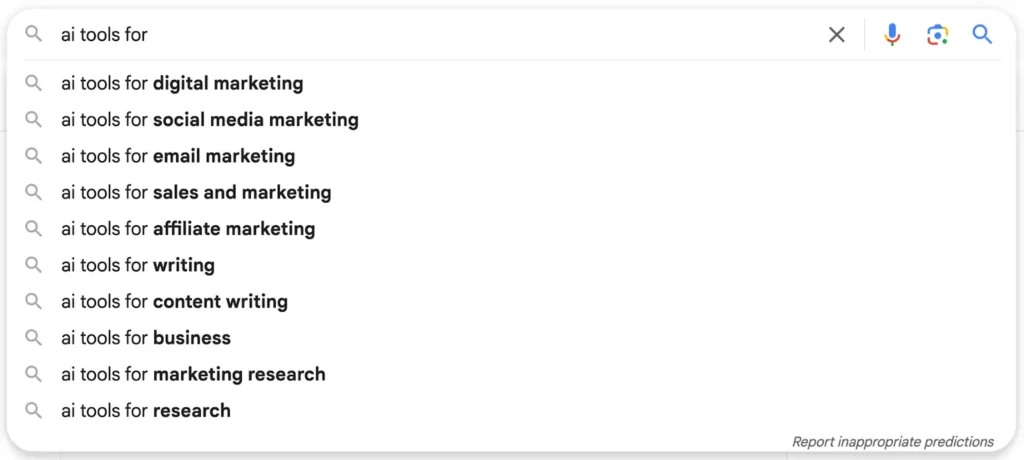It’s an AI world and we’re just living in it. That’s how it seems some days if you hang out on any social media platform for too long.
We all know that AI tech is proliferating rapidly and pervasively. One area of business that is incredibly popular, albeit contentious, is marketing.
Here’s a sample of some of the most popular searches related to AI marketing tools of late:

And one more just to see how deep AI tools are starting to go:

What Exactly Is an AI Marketing Tool—And Why Should You Care?
From chatbots answering questions in literal seconds to Netflix suggestions that seem like they’re inside your head, artificial intelligence is woven into our daily lives. But when it comes to marketing, AI isn’t just a passing fad, it’s an essential tool for smart marketers.
So, what is an AI marketing tool, exactly?
In simple terms, an AI marketing tool is a software or platform that uses AI techs (machine learning, natural language processing, and predictive analytics) to automate, optimize, and enhance marketing tasks. These tools are designed to make marketing teams smarter, faster, and more efficient by streamlining content creation to segmentation and almost everything in between.
Rather than replacing marketers, AI acts as a powerful partner (for now at least 😉). It sifts through your data, finds patterns, predicts behavior, and the latest and greatest can execute tasks in real time (sometimes referred to as Agentic AI).
Why Are Businesses Leaning Into AI Marketing Tools?
There are plenty of reasons companies of all sizes are making room for AI in their marketing stacks. Here are some of the main ones:
Get better customer insights faster
AI thrives on data. It can analyze everything from CRM records and web analytics to social media sentiment and purchase behavior in real time. The result? Deep, actionable insights about who your customers are and what makes them tick.
Popular solutions for customer insights that leverage AI:
- Customer Data Platforms (CDPs) like Segment or Bloomreach use AI to unify data from multiple sources and build rich customer profiles.
- Data Collaboration Platforms (DCPs) like Lotame use AI to help marketers identify patterns within their first-party data, segment customers, create lookalike audiences, and ultimately expand advertising reach and impact.
- Predictive analytics platforms like Salesforce Einstein or Pega identify trends and flag high-value prospects or likely churn risks.
- Social listening tools such as Brandwatch or Talkwalker apply AI to analyze online conversations and sentiment for market insights.
Whether it’s spotting patterns in buyer behavior or segmenting audiences with laser precision, AI helps marketers go beyond demographics and get to the why behind customer actions.
Personalize more experiences at a more detailed and wider scale
Modern consumers expect brands to know them—not in a creepy way, but in a “you remembered I liked this!” kind of way. AI allows businesses to deliver tailor-made experiences to thousands (or millions) of customers simultaneously.
Digital experience platforms that have integrated AI into their solution:
- Recommendation engines like Dynamic Yield or Adobe Target personalize website experiences based on browsing behavior.
- Email marketing platforms like Iterable, Klaviyo, and Mailchimp use AI to personalize subject lines, content blocks, and send times.
- AI-driven web personalization via tools like Optimizely and Mutiny adapts landing pages in real time based on user behavior.
These tools let marketers create a unique, relevant journey for every user—without manually segmenting audiences or hand-crafting dozens of variants.
Increase efficiency and automation across teams and campaigns
Let’s be real: no one got into marketing because they love repetitive admin tasks. AI swoops in to handle the busywork—scheduling, testing, posting—so teams can focus on creativity and strategy.
AI-enabled automation platforms:
- Marketing automation platforms like HubSpot, ActiveCampaign, and Marketo use AI to trigger campaigns based on user actions and behavior.
- Chatbots and virtual assistants like Drift, Intercom, or Tidio use NLP to respond to customer inquiries instantly—no human needed.
- Ad management platforms like Revealbot or Albert automate and optimize paid campaigns across platforms like Meta and Google.
This isn’t just about doing more with less—it’s about working smarter, not harder.
Have predictive analysis in an instant
Wouldn’t it be nice to know what your customers are going to do before they do it? Predictive analytics makes that possible. By analyzing historical and real-time data, AI can forecast trends, buyer behavior, and campaign performance.
AI-powered predictive intelligence tools:
- Lead scoring tools like Leadspace and Infer predict which prospects are most likely to convert.
- Customer retention platforms like Zinrelo or Custora (now part of Amperity) use predictive models to identify at-risk customers before they churn.
- Campaign forecasting tools in platforms like Google Ads Smart Bidding and Meta Advantage+ predict which ad variations will perform best.
This insight empowers marketers to allocate budget more effectively, time campaigns strategically, and improve ROI with fewer surprises.
Speed up the content ideation and creation process
AI isn’t just crunching numbers—it’s helping generate content, too. From copywriting to image generation, these tools help marketers move faster and stay consistent, especially under tight deadlines.
Highly recommended content ideation and creation tools with AI:
- AI writing assistants like Jasper and Copy.ai help brainstorm, draft, or refine marketing copy.
- Design platforms like Canva Magic Studio or Adobe Firefly use AI to create visuals, remove backgrounds, or generate new images from text.
- Video and audio tools like Synthesia (for AI-generated videos) or Descript (for editing audio and video with text) save tons of production time.
Important note: while these tools help kickstart creativity, they still work best with a human touch—someone to edit, fine-tune, and make sure the final result feels authentic and on-brand.
Make real-time decisions with up-to-date data
Marketing isn’t static. Consumer behavior changes by the minute—and AI gives marketers the agility to respond in real time, not weeks later.
Tools & technologies featuring AI:
- Real-time analytics dashboards like Google Analytics 4, Mixpanel, and Heap show how users are interacting with campaigns or websites instantly.
- Programmatic advertising platforms like The Trade Desk or AdRoll adjust ad spend and creative placement on the fly based on performance data.
- AI-powered A/B testing tools like VWO or Convert automatically direct traffic to top-performing variants without waiting for full test cycles.
The ability to pivot quickly means less wasted spend and better customer experiences—especially in fast-moving industries.
AI is a marketer’s dream, right? Think again.
As powerful as AI marketing tools can be, they’re not without their pitfalls. One of the most common issues is the risk of generating content that feels generic or off-brand. While AI can quickly produce copy, it often lacks the nuance, emotional intelligence, and brand voice that human writers bring to the table. Without careful editing and oversight, AI-generated content can miss the mark—sounding flat, repetitive, or even unintentionally awkward.
There are also growing concerns around data privacy and compliance. Many AI tools rely on extensive user data to function effectively, which can raise red flags in terms of regulations like GDPR, CCPA, or other data protection laws. Mishandling customer data or failing to disclose how it’s being used could damage brand trust and potentially lead to legal consequences.
Another challenge is the learning curve that comes with adopting AI technologies. While these tools promise ease and efficiency, getting the most out of them often requires training, onboarding, and in some cases, changes to team structure or workflows. Marketers need to invest time in understanding how to use the tools correctly, which can temporarily slow momentum during the transition phase.
Cost is also a consideration. Although there are plenty of affordable and freemium options out there, high-end AI platforms—especially those geared toward enterprise marketing—can come with steep price tags and long-term contracts. When not carefully chosen or fully utilized, these investments can turn into sunk costs.
Then there’s the issue of bias and inaccuracy. AI systems are only as good as the data they’re trained on. If that data contains outdated, skewed, or incomplete information, the outputs can reflect those same flaws. This could lead to tone-deaf messaging, incorrect targeting, or even inadvertently excluding certain audience segments.
Finally, there’s a very real risk of overdependence on automation. AI excels at handling repetitive tasks and optimizing processes, but it’s not a substitute for strategy, creativity, or human judgment. Relying too heavily on AI can lead to a “set it and forget it” mentality, where teams stop questioning the results or miss opportunities that don’t fit neatly into the algorithm.
It’s early in our AI journey as marketers. AI marketing tools have the potential to supercharge performance, streamline workflows, and unlock deeper customer insights—but they’re not a silver bullet. When used thoughtfully, they amplify human creativity and strategy. When misused or misunderstood, they can lead to generic content, missed opportunities, or data missteps. The key is treating AI as a powerful partner—not a replacement—in a fast-evolving, data-driven marketing landscape.
How Lotame Can Help
AI marketing tools aren’t just trendy—they’re table stakes. But knowing which tools to use, how to use them, and how to integrate them into a privacy-conscious, performance-driven strategy? That’s where the real advantage lies.
Whether you’re building your AI marketing stack from scratch or looking to level up with predictive insights, real-time decisioning, or addressable audience strategies, Lotame helps marketers move from experimentation to execution. From our Spherical Platform’s advanced data collaboration capabilities—like unifying fragmented first-party data, layering on AI-powered insights, and enabling secure partner collaborations without busting your budget or exhausting resources —to our AI-enhanced audience modeling and enrichment tools, Lotame helps you unlock smarter, faster, and easier marketing outcomes.
Let’s make AI work for your brand—not the other way around. Connect with us to get started.
Topics


